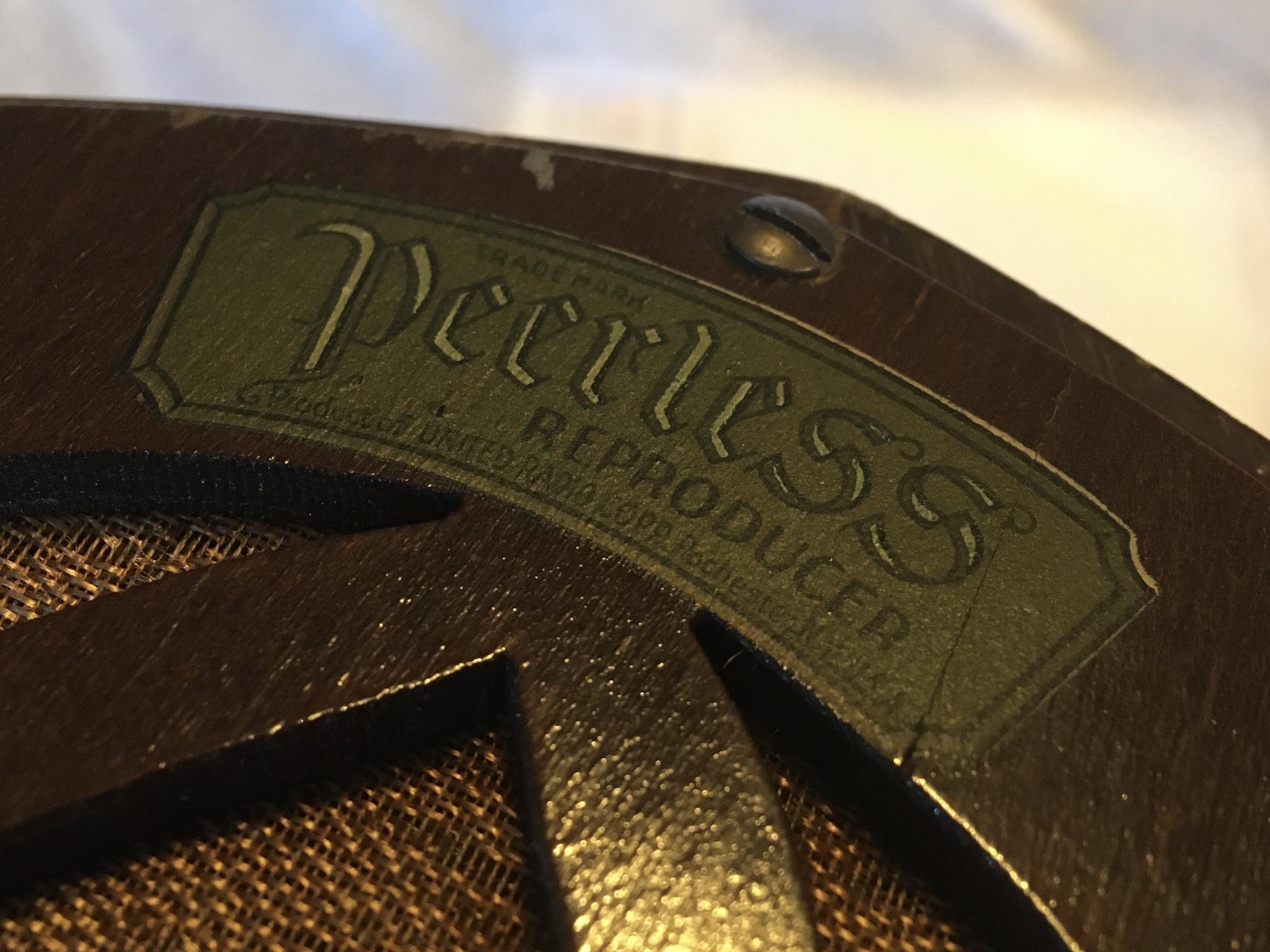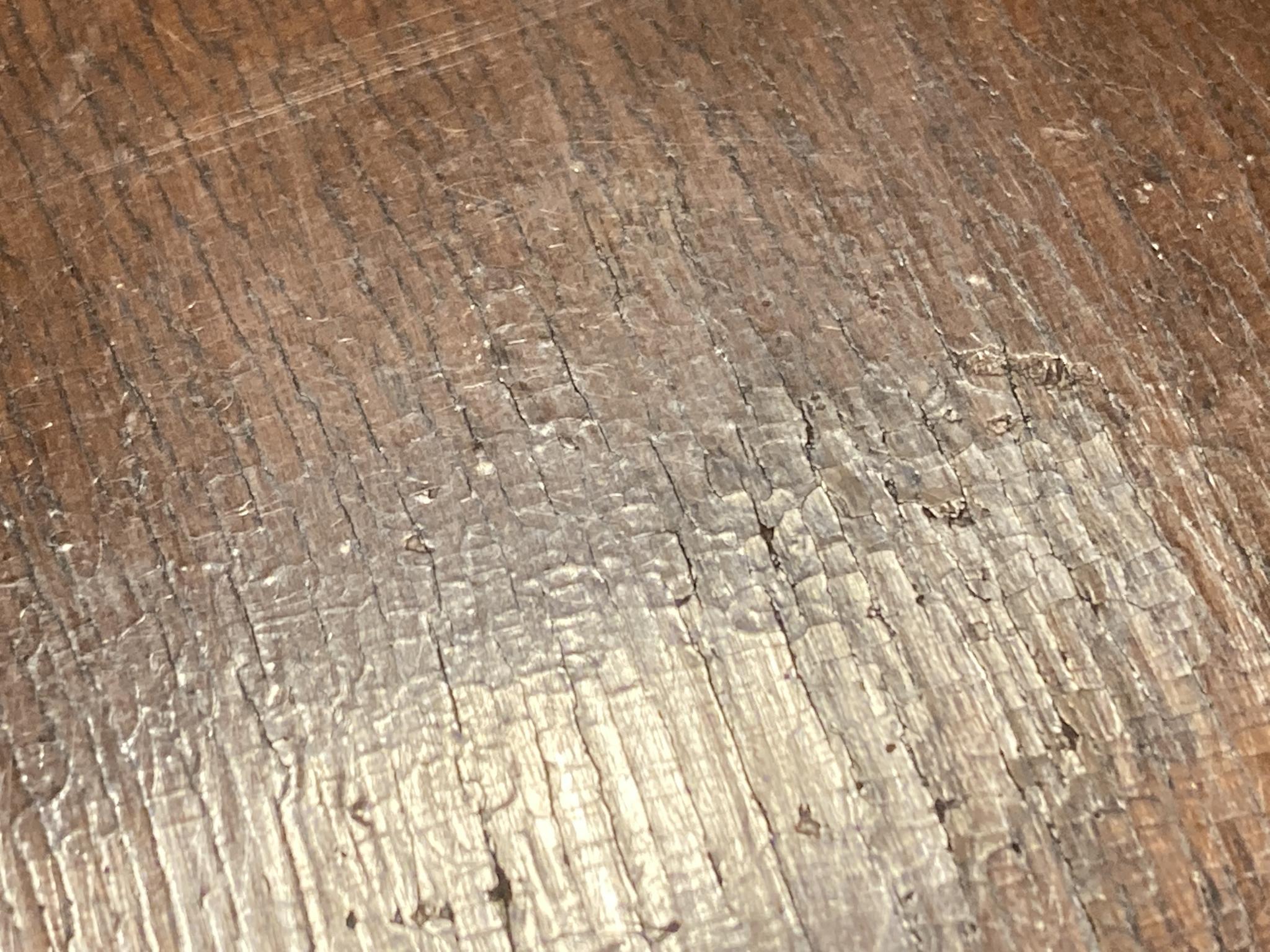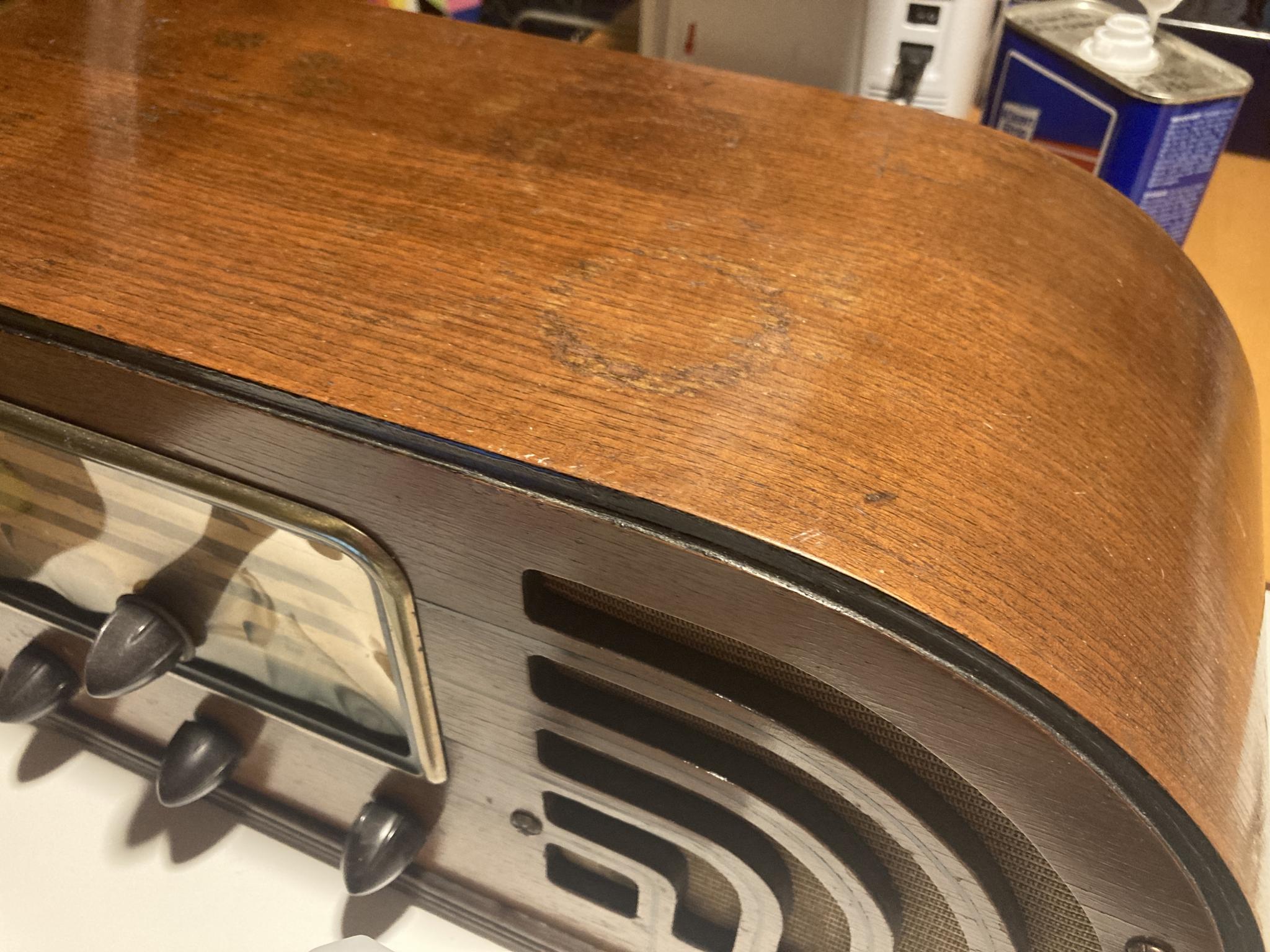Thanks for chiming in!
I will admit that I have not yet acted upon your advice. It turns out that 362 nm is an unusual frequency for easily available black lights, but I have found one that claims to be 320-400. I'll get one of them on the way here along with some shellac flakes - it should all be here on Friday. Then we shall begin the investigation. I might also veer into the F-63 as well. It's 6-7 years newer but does have a water ring on the top.
There is a sticker/decal on the back of the Peerless that I want to preserve. It looks like it might have been a waterslide type.

I bought two of the same UV bulbs at the same time, to illuminate a photo-stand; the other hasn’t been used as much, maybe the number isn’t as worn. I’ll look for it. You don’t absolutely have to have a blacklight, but it lets you know what you’re dealing with, and in cleaning an old finish, can let you see how you’re doing.
F-63? I haven’t been following that thread.
Yes, that is a waterslide decal; you’ll want to be especially cautious with cleaning it, they’re very easy to damage. They are paint, printed on a thin layer of animal hide glue which had been deposited on a paper substrate. I surely would like to read about the technology that was used to make them. My own experience is that cleaning a decal is nearly impossible; the hide glue ages badly and turns brown. The best you can do is remove aged varnish over it, hope it brightens the label. But I wouldn’t count on it. And when you’re cleaning it, one extra pass with a swab can remove the paint.
Water rings on a natural resin varnish are easy; they are a result of the varnish taking up moisture and fissuring the coating on a microscopic level. All you need to do is re-dissolve the varnish. We’ll get into that later, it’s integral to the French polishing technique.
-Dad
The lights and shellac flakes arrived over the weekend, so now it's time to take a look at this creature.
The F-63 is a 1937 radio that I modified a while back. It's in good shape, but it does have a water ring. I need to identify the finish on it. I'm not looking for museum quality restoration on these, but I do want to make them look good. Patina is okay, neglect is not.
Black light time! And it seems to have an olive green glow under the lights although I could be convinced it was an orange. Black light is odd. Cleaning with denatured alcohol (haven't picked up Everclear yet) didn't make any difference under the light, but it did make the finish a little more consistent and pulled up a bit more visible grain color variation on the spot I tried. It was subtle, though. The biggest difference I noticed is that it took some glossy variation off the surface, which may have been cleaning.
On the F-63, same green but stronger. The water ring is purple. Looking at it, it goes quite deep. Wiping this one with denatured alcohol didn't change the color but it did make the finish a bit sticky and smoothed over some fine cracking in the surface. This one seemed to react much more to the alcohol, and I could easily believe that the alcohol was melting the finish and letting it resettle.
I'm honestly more interested in the F-63 as it's a nicer piece with more damage that lives on my bedside table. I don't mind learning on the Peerless if it's the same sort of finish.
Here's a closeup of the texture on an untouched part of the F-63.

Overall surface.

Olive-green to dirty green is a synthetic finish, anything from early cellulose nitrate to alkyd varnish to polyurethane. The cracquelure in your picture (good raking-light shot, by the way!) is typical of aged cellulose nitrate lacquer. See the cross-cracking? Generally, lengthwise cracks appear as the veneer expands and contracts, but there is some movement of the veneer lengthwise, and over time the lacquer also shrinks. I'm sorry to tell you this, but there is no recovering/salvaging an aged nitrocellulose lacquer; it has a definite lifespan. God knows I've tried; I once tried to salvage an original nitrocellulose finish on a 1960s legislative desk from the Florida House. I made it look better, but the old, brittle lacquer was still underneath, was still easily damaged.
I don't like to say this, but the only cure for a deteriorated nitrocellulose coating is stripping, refinishing. I have done too much of that, too much history down the drain. You can improve its appearance, but you won't rejuvenate the aged lacquer.
The purple color was straight reflection of the UV light - the finish is gone there. And very few woods fluoresce, in any color. The water ring toward the face of the radio looks like it has some staining in the wood; I would use oxalic acid to reduce the stain (small brush, #1!. I used to be able to buy small quantities of oxalic acid from Tandy's Leather; now I buy it in crystalline form, in bulk. It's also good at removing rust stains.) When it has dried, neutralize the acid with a solution of baking soda, wipe it dry, swab with water (preferably distilled), wipe that, and let it dry thoroughly. Then touch up both rings with a clear lacquer or blonde shellac and a small brush, small strokes until the ring is not obvious.
But the Peerless speaker, with a spirit-soluble varnish, will be a different matter. Its finish is still salvageable.
In reply to Asas_Dad :
Apologies, Keith; I just re-read your post and realized I was confusing your findings on the speaker with the radio. It's entirely possible that some previous owner wiped the speaker down with an oil-based varnish in an attempt to brighten the finish. Check the spot you've already cleaned with alcohol with the blacklight. And on the back of the speaker, put a few drops of mineral spirits on 400-grit wet-or-dry sandpaper, sand a small spot lightly, wipe dry, tell me what the UV reveals.
But everything I've said about nitrocellulose lacquer on the radio still stands.
Well, better to know what I'm dealing with than to wonder. I'll take a look at how the speaker reacts with that little bit of sanding - it didn't fluoresce as much as the radio, so maybe it can be cleaned. Definitely the same color under the light though. Looking at it, it could very well have received a top coat at some time although the color seems to match other Peerless speakers I've seen in photos.
Any theories as to why the finish on the radio softened and seemed to smooth out with the alcohol? That's the one you identified as cellulose nitrate for sure.
This is all very interesting. It's a shame neither of them was suitable for rejuvenation because then I would have learned some new skills.
In reply to Keith Tanner :
You had said that you could almost convince yourself that the fluorescence off the speaker was orange - that makes me wonder if there is shellac under the current coating, which might be only whisper-thin. Are there obvious brush marks in the top coat, or does it show greenish wiping streaks under UV? And if you were able to remove some of the finish with alcohol, there must have been a spirit varnish on it. Try this: on the reverse of the speaker, assuming the back fluoresces the same as the front (you always want to do your testing on the back of an object, or failing that, down low on a side where it won't show), dip a swab in toluene or xylene, wet a small spot on the surface and leave the swab lying there. When the swab is almost dry, check under it. If an alkyd or oil-based varnish has been applied over over a spirit varnish, the alkyd should have swelled, softened, pulled up. You should be able to roll it off without damage to a spirit-varnish. Toluene and xylene are non-polar solvents; alcohol-soluble varnishes are only affected by polar solvents, such as alcohol, ketones. Tell me what you find, and look at the results with both visible and UV light.
No, sorry, I don't know why the alcohol might have softened the finish on the radio. That craquelure is classic for nitrocellulose lacquer. How soft? Did it actually dissolve and flow out, even locally? I have never heard of a nitrocellulose lacquer that was strongly affected by alcohol. Back in its heyday, you could order any formulation of lacquer that met your needs - there were thousands. And though there might have been alcohols in the original solvent, it doesn't mean that the nitrocellulose was soluble in it, they were in it to perform some other function, like speed or slow the drying.
I've even heard of guys who went to the length of washing old nitrocellulose off with lacquer thinner, catching it, straining it, re-dissolving it, re-applying it. But they're still just re-applying a finish that has gone beyond it's age. I'm not sure I see the point, seems a little anal.
It's difficult, trying to do this long-distance, where I can neither see the effects of the tests, nor follow-up on them.
But courage, Keith; you can improve the looks of the finish on the radio. It just requires a different direction from the speaker. Let's take them separately. First, reduce the staining in that one water-ring with oxalic acid.
Dad
In reply to Keith Tanner :
Hi Keith,
I hope it's okay to come onto a 5 year old post and ask a few questions. I'm not a Hot Rodder but I am the daughter of a Mini Sprint car racer so hopefully that gives me some track cred, is that a thing? Anyway, I wanted to make sure I understand the need for the transformer, it's not the amps but the resistance that needs to be converted? I should also probably say I don't know what either of those things actually is. I can use either Airplay or Bluetooth for this speaker and I had been looking at this guy for the project (https://www.ebay.com/itm/401183901515?var=670753650526) but I didn't realize I had to reduce/convert anything to use the original speaker. I'm okay with it sounding old but I don't want to destroy anything. Would this thing work or should I do what you did and how do I know where to put the red and black wires on the old speaker? I read something about not wanting to damage the magnet by crossing the wires. Lastly, no soldering here right? I don't know that I trust myself with that.
Thanks,
Adele
What we're looking at is the speaker impedance. Basically, a modern amp won't be able to drive that speaker without help.
https://geoffthegreygeek.com/understanding-speaker-impedance/
As for soldering, it's been a while but I'm pretty sure all the connections were screw terminals. I don't think you can damage the magnet by getting the polarity wrong, that would just flip the phase which is not a big deal unless you're running stereo speakers. Where damage comes in is if you've got multiple speakers out of phase and they're cancelling each other out so you keep driving them harder.
You'll need to log in to post.